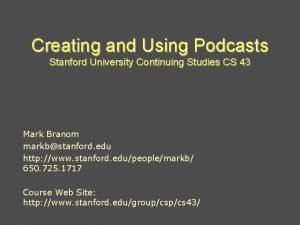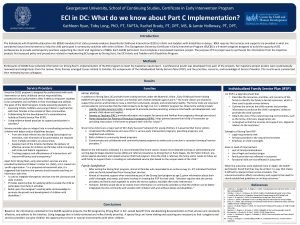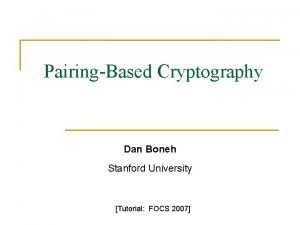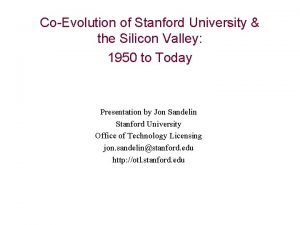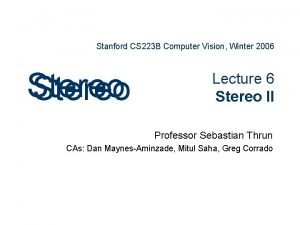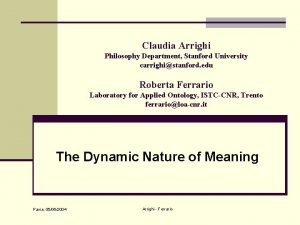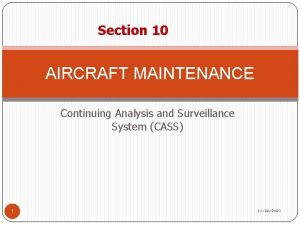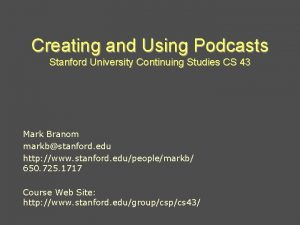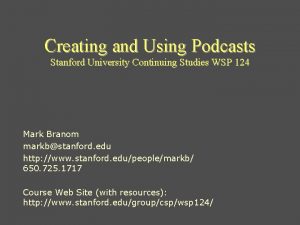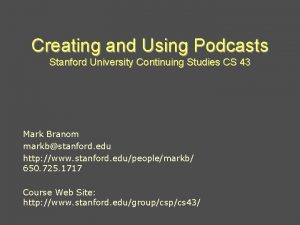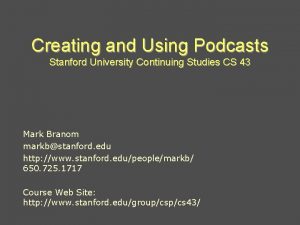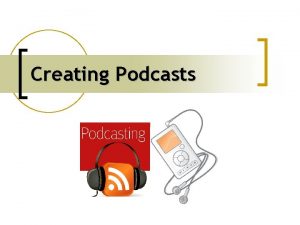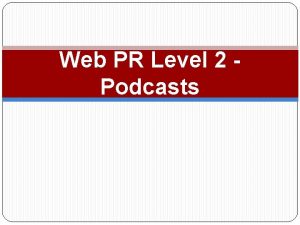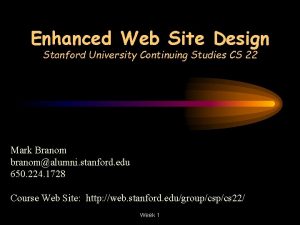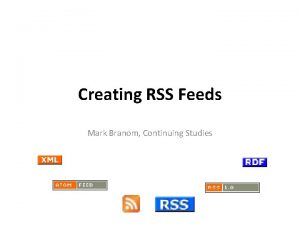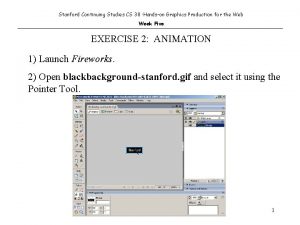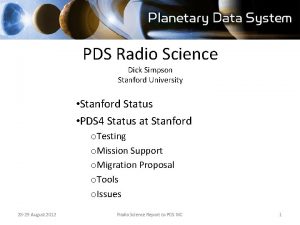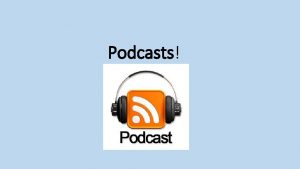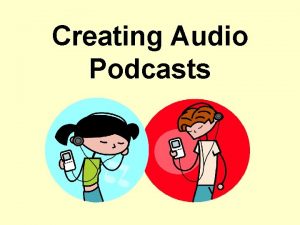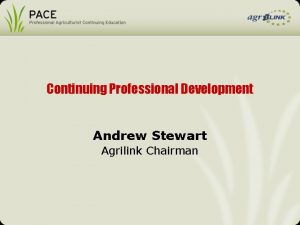Creating and Using Podcasts Stanford University Continuing Studies
























- Slides: 24

Creating and Using Podcasts Stanford University Continuing Studies CS 43 Mark Branom markb@stanford. edu http: //www. stanford. edu/people/markb/ 650. 725. 1717 Course Web Site: http: //www. stanford. edu/group/cs 43/

Course Description • Podcasting has become the most cost-effective and efficient way to distribute digital audio and video files via the Web. By subscribing to podcasts, listeners and viewers can consume valuable information whenever they need to, not just whenever a broadcaster decides to present it. • In this hands-on course, you will learn the skills needed to develop, create, and publish engaging podcasts. Topics include: how to find and subscribe to podcasts, how to use software (e. g. , Audacity) to create sound files for podcasts on the computer, how to plan and record your podcasts, how to edit, produce and publish them, and more. By the end of the course, students will know how to create and publish their podcasts from start to finish. 2

Administrivia Grading You have the option of taking this course for a letter grade, CR/NC, or as an Audit. Letter Grade Attendance Required Homework Required Project Required By request CR/NC Required NGR Recommended Not required By Request Default choice 3

More Administrivia • Resources – Each week you will receive supplemental handouts and in-class exercises. Copies of the handouts and links to resources will be posted to the CS 43 website: • http: //www. stanford. edu/group/cs 43/ • How to reach me: – markb@stanford. edu – 650 -725 -1717 4

More Administrivia • You will need: – – – Access to a computer Familiarity with computer basics Access to the internet (many free ISPs exist) A tripod account (we’ll do it in class) Access to the following tools: • • A text editor (Text. Edit for Macs; Notepad for Windows) A web browser (Firefox / Internet Explorer) Audacity A microphone 5

Course Agenda • • Week 1: Obtaining, Using, Planning for Podcasts Week 2: Recording the Audio Podcast Week 3: Editing the Podcast Week 4: Creating the XML (RSS) feed, Setting Up a Blog, and Publishing the Podcast! • Week 5: Wrap-up and editing, Video Podcasts 6

Assignments & Final Project • The weekly class assignments will build toward the final project • The final project will be to create and publish a 3 -5 minute podcast – an audio or video file and an RSS feed advertising the podcast. • The final project will be turned in by sending the instructor (Mark Branom at markb@stanford. edu) an email with the location of the RSS feed. • Due date for the final project: Wednesday, December 12, 2007 7

Introduction What Is a Podcast? “Podcasting is the method of distributing multimedia files, such as audio programs or music videos, over the Internet using either the RSS or Atom syndication formats, for playback on mobile devices and personal computers. ” (wikipedia. org) Media File + Advertising via RSS = Podcast 8

Why Use and/or Create Podcasts? • For Companies, Universities, or Organizations: Podcasts can deliver information about a department or group internally (to just the department), to the organization as a whole, or to the entire world. Podcasts can be used for newsworthy events in the department, for highlighting special events and/or people in the department, and for presenting and disseminating other information to the desired audience in an engaging manner. • For Teachers and Other Instructors (or staff supporting them): Podcasts can deliver educational content for listening or viewing on a computer and/or i. Pod, freeing learning from constraints of the physical classroom. Content could be anything from curriculum-related presentations to professional development ideas and used to disseminate best practices between other faculty. Instructors can easily create a podcast of daily assignments and class lectures from class, and publish it for all of their students. 9

Why Use and/or Create Podcasts? • For Individuals: Podcasts allow you to express yourself in a less-formal, more friendly manner than the written word allows. When communicating via the written word (sending email, snail mail, blogging, creating web pages, or writing books), you are limited by the medium – although you can indicate emphasis by bolding or italicizing, it’s difficult to indicate such things as sarcasm, emotion, or tone. Since podcasting involves the spoken word, and since speech is a less formal method of expression, you can convey such emotional tones more effectively. 10

Locating and Obtaining Podcasts – Podcast search engines allow you to find podcasts: • www. apple. com/itunes/ • www. google. com/Top/Computers/Internet/On_the_Web/Podcasts/Directories/ • www. podscope. com/ • getapodcast. com/ • podcast. net/ • podcastdirectory. com/ • www. allpodcasts. com/ – Podcatcher software automatically downloads podcasts to your computer and/or i. Pod or other media device: • www. apple. com/itunes/ • juicereciever. sourceforge. net/ • www. podcastingnews. com/topics/Podcast_Software. html 11

In-class Exercise 1: Using Juice 1. Download, install, and run Juice Receiver: http: //juicereceiver. sourceforge. net/ 2. Subscribe to a podcast, such as NPR’s Car Talk: 1. Go to http: //www. npr. org/podcasts/ 2. Click By Title, then C. 3. Click NPR: Car Talk. 4. In the POD section, copy the URL. 5. Return to Juice. 6. In the Subscriptions tab, click the plus sign. 7. In the URL field, paste the link from step 4. 8. Click Save. 9. Click the Check for New Podcasts button. 10. Double-click the podcast to listen. 12

In-class Exercise 2: Using i. Tunes 1. 2. 3. 4. 5. 6. Open i. Tunes. In the Store section, click i. Tunes Store. In the i. Tunes STORE section, click Podcasts. Click Today’s Top Podcast. Click Subscribe to subscribe to the podcast. To listen to the podcast, in the Library, click Podcasts. Then, double-click the podcast. 13

Creating a Podcast Planning a Podcast 1) Research your topic. 2) Write out what you plan to say. 3) Block out the segments of your podcast. a) Typical 60 -minute radio show: 1. 2. 3. 4. 5. 6. 7. 8. Introduction and “hook” (a snapshot of what is covered and why listeners would want to listen) Segment 1 Break Segment 2 Break Segment 3 Break Final points and summary of podcast b) Typical 10 -minute podcast: 1. 2. 3. 4. Introduction and “hook” Main segment Summary of segment Final points 14

In-class Exercise/Homework: Mapping Out a Podcast 1. Next week, you will pair up with the person sitting next to you. 2. Map out a one-minute podcast with your neighbor. Don’t record it (we’ll do that later); just plan what you will say. a. Introduce yourself “Hello, and welcome to the [Your. Name] show. I’m your host, [Your. Name]. Today I’ll be interviewing [Neighbor. Name]. ” b. Interview the person sitting next to you 1) 2) 3) 4) “So, [Neighbor. Name], please tell the listeners a little about yourself. ” “I see, and where do you live? ” “What exciting things are going on in the neighborhood? ” “Anything else you would like to add? ” c. Closing remarks “Well, [Neighbor. Name], it looks like we’ve come to the end of time for the show. Thank you so much for allowing our audience to learn a little more about you and your neighborhood. This is [Your. Name], and you’ve been listening to the [Your. Name] Show, brought to you by Stanford University and the Continuing Studies department. Until next time, thanks for listening. ” § Then, you will switch roles with your neighbor and practice again. 15

Recording and Editing Podcasts To record a podcast, you’ll need: 1. A computer (any modern computer will do – Mac, Windows, Linux) 2. A microphone (a good microphone will cost around $100) http: //radio. about. com/od/podcastin 1/a/blcomparemikes. htm 3. Software to record and edit the podcast. For audio podcasts, Audacity is a good choice. For video podcasts, Windows Movie Maker (Windows) and i. Movie (Mac) are good choices. 4. Storage for the audio file you create (a web server such as Tripod, a free podcasting service such as Podshow or Podbean, etc. ) 16

Software: Audio Software – Free tools • Audacity (Mac/Windows): http: //audacity. sourceforge. net/ • Garage. Band (Mac only – it’s part of i. Life, and is free with new Macs): http: //www. apple. com/ilife/garageband/ – Other tools ($35 - $500) • Audition (Windows only): http: //www. adobe. com/products/audition/ • Soundbooth (Mac/Windows): http: //www. adobe. com/products/soundbooth/ • Sound. Edit Pro (Windows only): http: //www. rmbsoft. com/sep. asp 17

Software: Video Software – i. Movie (Macintosh only): http: //www. apple. com/ilife/imovie/ – Windows Movie Maker (Windows only): http: //www. microsoft. com/windowsxp/using/moviemaker/create/ – Avid Free. DV (Mac/Windows): http: //www. avid. com/freedv/ – Movie. Works (Mac/Windows): http: //www. movieworks. com/ – Quicktime (Mac/Windows): http: //www. quicktime. com/ – Director (Mac/Windows): http: //www. adobe. com/products/director/ – Windows. Media: http: //www. microsoft. com/windowsmedia/ 18

RSS Feeds • What is RSS (Really Simple Syndication)? “RSS is a family of web feed formats used to publish frequently updated content such as blog entries, news headlines or podcasts. An RSS document, which is called a "feed, " "web feed, " or "channel, " contains either a summary of content from an associated web site or the full text. RSS makes it possible for people to keep up with their favorite web sites in an automated manner that's easier than checking them manually. ” (wikipedia. org) • An excellent 2 -minute video explaining RSS in plain English is at: http: //www. commoncraft. com/rss_plain_english 19

RSS Feeds, continued • RSS feeds are XML files. Here is a sample RSS feed: <? xml version="1. 0"? > <rss version="2. 0"> <channel> <title>Title of Feed Goes Here</title> <description>Description of Feed Goes Here</description> <link>Link to the Feed Goes Here</link> <item> <title>Title of Podcast Goes Here</title> <description>Description of Podcast</description> <link>Link to Podcast</link> <guid>Link to Podcast</guid> <enclosure url="Link to Podcast" type="audio/mpeg" length="file size in bytes" /> </item> </channel> </rss> 20

Submitting RSS Feeds • Doing it yourself: Yahoo MSN Search Fyber Search Bulk Feeds Truth Laid Bear Moreover Blog Street Memigo Feeds Farm Blogarama News Knowledge Blog Wise News Trove Every Feed Blog SE Syndic 8 Boing RSS Clipping Fastbuzz Eatonweb Newsmob 2 RSS Feedster Search 4 RSS Anse Sourceforge Blog Digger Day Pop Feed-Directory Sarthak Bloggernity Bloogz Technorati News Is Free Rocket Info Genecast Easy RSS Postami Topix Headline Spot Blogdex Feed Directory Pub Sub Blog Tree Findory Blog Catalog Step Newz We. Blog. ALot News Goblin News Feedplex Popdex Newzfire Read A Blog Pulse Press Radar Rub Hub Feed 24 Feeds. For. All Blog Map Weblogs Feed Burner Blo. gs Blog. Rolling Technorati News. Gator Pingomatic RSS Network Plazoo Feedzie Feed Cat Feed Miner Ice Rocket Sphere Moz Dex Uncle Feed Pluck RSS Locator News Net Plus Focus Look Blog Bunch Blogtastic Explore Blogs Feed Pub Feeds 2 Read RSS Directory House Of Blogs RSS Mad Blog Resource Feed Burner All Feeds Content Desk Feed See Blog Watch 4 Guys. From. Rolla Gnoos Octora RSSMicro Feedooyoo Golden Feed RSS-Feeds-Sub Readafeed Feedage Rorseek RSS Junky Feed Fury News on Feeds 21

Submitting RSS Feeds, continued • Using a service – http: //itunes. apple. com/ – http: //www. submitrssfeed. com/ – http: //www. feedsubmitter. com/ – http: //www. dummysoftware. com/rsssubmit. html – http: //allrss. com/rsssubmission. html 22

Creating a Transcript • Be sure to create a transcript of your podcast. • Having a transcript is important for accessibility reasons, but also since some people might not have the time to listen to the entire podcast, they might prefer to skim through the transcript to see what your podcast contains. • Further, if you add a transcript to your podcast, you can make searching through your podcast much easier by search engines as well as human beings (i. e. , at timestamp 3 minutes, 22 seconds the speaker begins talking about the influence of computers on society). • While it is time-consuming to do it yourself, here are some places you can go to have transcripts created for you: – http: //castingwords. com/ – http: //www. docsoft. com/ – http: //www. automaticsync. com/ 23

Homework / Next Week • Homework: – Create a transcript for a 1 -minute podcast similar to what we did in class today. We’ll record it next week! • Next week: – – Establishing a Tripod account The Basics of Audacity Recording a podcast Minor editing using Audacity (major editing will occur the following week) 24
 Stanford continuing studies certificate
Stanford continuing studies certificate Podcasts for learning
Podcasts for learning Georgetown school of continuing studies reputation
Georgetown school of continuing studies reputation Oxford continuing education
Oxford continuing education Paradigm shift from women studies to gender studies
Paradigm shift from women studies to gender studies Stanford security awareness
Stanford security awareness Stanford university
Stanford university Steve jobs stanford commencement address
Steve jobs stanford commencement address Stanford university cryptography
Stanford university cryptography Dr. ash from stanford university
Dr. ash from stanford university Silicon valley stanford university
Silicon valley stanford university Stanford university
Stanford university Stanford university
Stanford university Claudia arrighi
Claudia arrighi Cara belajar orang dewasa
Cara belajar orang dewasa Continuing analysis and surveillance system
Continuing analysis and surveillance system 4.3 using studies wisely
4.3 using studies wisely Herszon kherson maritime college of merchant marine fleet
Herszon kherson maritime college of merchant marine fleet Bucharest university of economic studies ranking
Bucharest university of economic studies ranking Ajou university graduate school of international studies
Ajou university graduate school of international studies Jane jacobs columbia university school of general studies
Jane jacobs columbia university school of general studies Beijing foreign studies university accommodation
Beijing foreign studies university accommodation Describing visual data
Describing visual data San diego continuing education north city campus
San diego continuing education north city campus Tbpe roster
Tbpe roster
